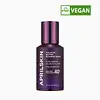What's inside
What's inside
 Key Ingredients
Key Ingredients

 Benefits
Benefits

 Concerns
Concerns

 Ingredients Side-by-side
Ingredients Side-by-side

Water
Skin ConditioningDipropylene Glycol
HumectantGlycerin
HumectantHamamelis Virginiana Extract
AntiseborrhoeicButylene Glycol
HumectantArginine
MaskingCarbomer
Emulsion StabilisingCaprylyl Glycol
EmollientBetaine
HumectantAllantoin
Skin ConditioningPanthenol
Skin ConditioningCamellia Sinensis Leaf Extract
AntimicrobialRosmarinus Officinalis Leaf Extract
AntimicrobialChamomilla Recutita Flower Extract
MaskingCentella Asiatica Extract
CleansingGlycyrrhiza Glabra Root Extract
BleachingAdenosine
Skin ConditioningDisodium EDTA
Polygonum Cuspidatum Root Extract
AntioxidantScutellaria Baicalensis Root Extract
AstringentIllicium Verum Fruit Extract
PerfumingSodium Hyaluronate
HumectantPolyglutamic Acid
Skin ConditioningNatto Gum
Copper Tripeptide-1
Skin ConditioningAcetyl Hexapeptide-8
HumectantPalmitoyl Pentapeptide-4
Skin ConditioningWater, Dipropylene Glycol, Glycerin, Hamamelis Virginiana Extract, Butylene Glycol, Arginine, Carbomer, Caprylyl Glycol, Betaine, Allantoin, Panthenol, Camellia Sinensis Leaf Extract, Rosmarinus Officinalis Leaf Extract, Chamomilla Recutita Flower Extract, Centella Asiatica Extract, Glycyrrhiza Glabra Root Extract, Adenosine, Disodium EDTA, Polygonum Cuspidatum Root Extract, Scutellaria Baicalensis Root Extract, Illicium Verum Fruit Extract, Sodium Hyaluronate, Polyglutamic Acid, Natto Gum, Copper Tripeptide-1, Acetyl Hexapeptide-8, Palmitoyl Pentapeptide-4
Soluble Collagen
HumectantWater
Skin ConditioningMethyl Gluceth-20
HumectantGlycereth-26
HumectantGlycerin
Humectant1,2-Hexanediol
Skin ConditioningNiacinamide
SmoothingArtemisia Vulgaris Extract
Skin ConditioningPropylene Glycol Dibenzoate
Skin ConditioningSorbeth-30 Tetraoleate
EmulsifyingC12-14 Pareth-12
EmulsifyingGlyceryl Acrylate/Acrylic Acid Copolymer
HumectantPolyglycerin-3
HumectantMethyl Gluceth-10
EmulsifyingTromethamine
BufferingAcrylates/C10-30 Alkyl Acrylate Crosspolymer
Emulsion StabilisingGardenia Florida Fruit Extract
Skin ConditioningPentaerythrityl Tetraisostearate
EmollientSodium Hyaluronate
HumectantAdenosine
Skin ConditioningDextrin
AbsorbentEthylhexylglycerin
Skin ConditioningButylene Glycol
HumectantHyaluronic Acid
HumectantPalmitoyl Tripeptide-5
Skin ConditioningSimmondsia Chinensis Seed Oil
EmollientOryza Sativa Bran Extract
Skin ConditioningButyrospermum Parkii Butter
Skin ConditioningSqualane
EmollientCaprylyl Glycol
EmollientSorbitan Laurate
EmulsifyingHydrolyzed Hyaluronic Acid
HumectantHydrolyzed Sodium Hyaluronate
Skin ConditioningSodium Hyaluronate Crosspolymer
HumectantHydroxyethylcellulose
Emulsion StabilisingAcetyl Dipeptide-1 Cetyl Ester
Skin ConditioningHydroxypropyltrimonium Hyaluronate
Acetyl Hexapeptide-1
Skin ConditioningSorbitan Sesquioleate
EmulsifyingSodium Polyacryloyldimethyl Taurate
Emulsion StabilisingSodium Acetylated Hyaluronate
HumectantDiphenyl Dimethicone
EmollientTriethylhexanoin
MaskingHydrogenated Lecithin
EmulsifyingPolyglyceryl-10 Oleate
Skin ConditioningSoluble Collagen, Water, Methyl Gluceth-20, Glycereth-26, Glycerin, 1,2-Hexanediol, Niacinamide, Artemisia Vulgaris Extract, Propylene Glycol Dibenzoate, Sorbeth-30 Tetraoleate, C12-14 Pareth-12, Glyceryl Acrylate/Acrylic Acid Copolymer, Polyglycerin-3, Methyl Gluceth-10, Tromethamine, Acrylates/C10-30 Alkyl Acrylate Crosspolymer, Gardenia Florida Fruit Extract, Pentaerythrityl Tetraisostearate, Sodium Hyaluronate, Adenosine, Dextrin, Ethylhexylglycerin, Butylene Glycol, Hyaluronic Acid, Palmitoyl Tripeptide-5, Simmondsia Chinensis Seed Oil, Oryza Sativa Bran Extract, Butyrospermum Parkii Butter, Squalane, Caprylyl Glycol, Sorbitan Laurate, Hydrolyzed Hyaluronic Acid, Hydrolyzed Sodium Hyaluronate, Sodium Hyaluronate Crosspolymer, Hydroxyethylcellulose, Acetyl Dipeptide-1 Cetyl Ester, Hydroxypropyltrimonium Hyaluronate, Acetyl Hexapeptide-1, Sorbitan Sesquioleate, Sodium Polyacryloyldimethyl Taurate, Sodium Acetylated Hyaluronate, Diphenyl Dimethicone, Triethylhexanoin, Hydrogenated Lecithin, Polyglyceryl-10 Oleate
 Reviews
Reviews

Ingredients Explained
These ingredients are found in both products.
Ingredients higher up in an ingredient list are typically present in a larger amount.
Adenosine is in every living organism. It is one of four components in nucleic acids that helps store our DNA.
Adenosine has many benefits when used. These benefits include hydrating the skin, smoothing skin, and reducing wrinkles. Once applied, adenosine increases collagen production. It also helps with improving firmness and tissue repair.
Studies have found adenosine may also help with wound healing.
In skincare products, Adenosine is usually derived from yeast.
Learn more about AdenosineButylene Glycol (or BG) is used within cosmetic products for a few different reasons:
Overall, Butylene Glycol is a safe and well-rounded ingredient that works well with other ingredients.
Though this ingredient works well with most skin types, some people with sensitive skin may experience a reaction such as allergic rashes, closed comedones, or itchiness.
Learn more about Butylene GlycolCaprylyl Glycol is a humectant and emollient, meaning it attracts and preserves moisture.
It is a common ingredient in many products, especially those designed to hydrate skin. The primary benefits are retaining moisture, skin softening, and promoting a healthy skin barrier.
Though Caprylyl Glycol is an alcohol derived from fatty acids, it is not the kind that can dry out skin.
This ingredient is also used as a preservative to extend the life of products. It has slight antimicrobial properties.
Learn more about Caprylyl GlycolGlycerin is already naturally found in your skin. It helps moisturize and protect your skin.
A study from 2016 found glycerin to be more effective as a humectant than AHAs and hyaluronic acid.
As a humectant, it helps the skin stay hydrated by pulling moisture to your skin. The low molecular weight of glycerin allows it to pull moisture into the deeper layers of your skin.
Hydrated skin improves your skin barrier; Your skin barrier helps protect against irritants and bacteria.
Glycerin has also been found to have antimicrobial and antiviral properties. Due to these properties, glycerin is often used in wound and burn treatments.
In cosmetics, glycerin is usually derived from plants such as soybean or palm. However, it can also be sourced from animals, such as tallow or animal fat.
This ingredient is organic, colorless, odorless, and non-toxic.
Glycerin is the name for this ingredient in American English. British English uses Glycerol/Glycerine.
Learn more about GlycerinSodium Hyaluronate is hyaluronic acid's salt form. It is commonly derived from the sodium salt of hyaluronic acid.
Like hyaluronic acid, it is great at holding water and acts as a humectant. This makes it a great skin hydrating ingredient.
Sodium Hyaluronate is naturally occurring in our bodies and is mostly found in eye fluid and joints.
These are some other common types of Hyaluronic Acid:
Learn more about Sodium HyaluronateWater. It's the most common cosmetic ingredient of all. You'll usually see it at the top of ingredient lists, meaning that it makes up the largest part of the product.
So why is it so popular? Water most often acts as a solvent - this means that it helps dissolve other ingredients into the formulation.
You'll also recognize water as that liquid we all need to stay alive. If you see this, drink a glass of water. Stay hydrated!
Learn more about Water